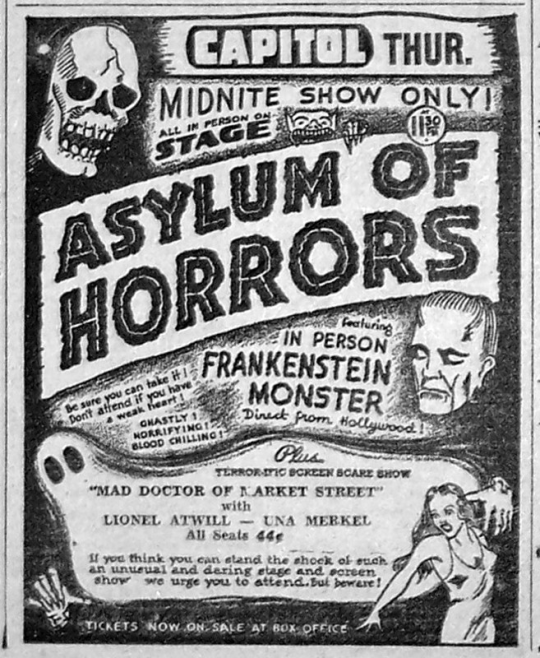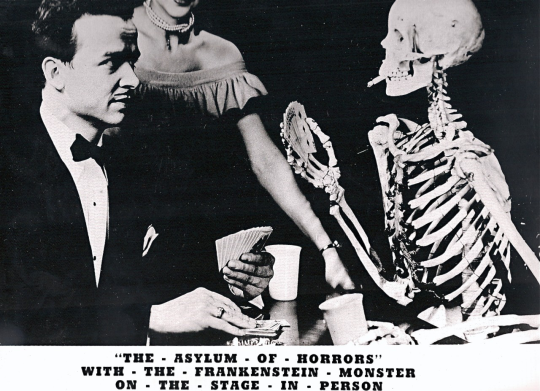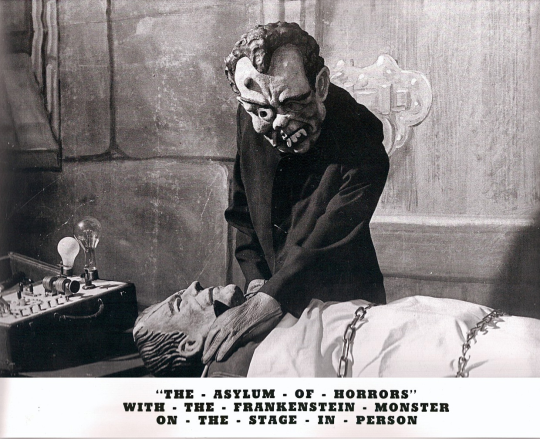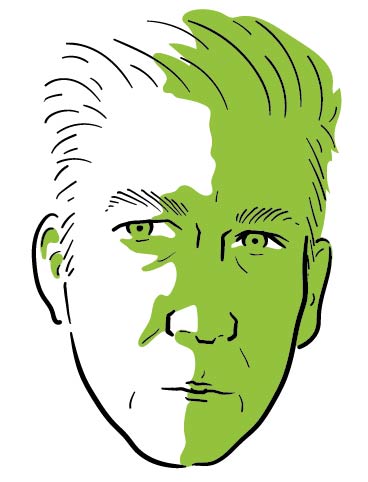
Jim Knipfel on Dr. Silkini’s Asylum of Horrors
Around the turn of the Twentieth century, the American public’s desperate, insatiable fascination with spiritualism and its promise of communication with dead family members made it a golden era for self-proclaimed clairvoyants, mystics, mediums, and charlatans of all stripes. All a so-called spiritualist had to do was hang a shingle outside his parlor door and the suckers would line up down the street, just waiting to be plucked. Following the death of his mother, Harry Houdini found even he was not immune to the hysteria. Having both hopes and serious doubts, he approached the spirit world scientifically, undertaking (along with Arthur Conan Doyle, among others) an investigation into the claims of the supposed mystics.
Houdini attended a seance in 1921 where, like everybody else sitting around the table, he saw apparitions materialize, objects levitate without any human intervention, and heard otherworldly noises. Being Houdini, however, it didn’t take him long to recognize what he was witnessing were not actual ectoplasmic manifestations from the other side, but a collection of cheap magic tricks, and tired ones at that. These were tricks no serious professional magician in his right mind would use anymore for fear of being laughed off the stage. But with an audience already primed and eager to believe that what they were seeing was real, these dusty old gaffes worked like a charm, and the sad rubes were willing to fork over their life savings to see more. From that point on Houdini made a second career of traveling the country, debunking these spiritual frauds one after another.
Appropriately enough, Houdini died on October 31st, 1926, and in the years that followed the vaudeville that helped spread his fame was beginning to fade with the arrival of talkies and radio. All those thousands of magicians who’d been working the circuit steadily for years suddenly found themselves wondering what the hell to do next. There wasn’t much call for magic on the radio, and the movies were still magic enough in themselves that some card tricks and silk handkerchief gags weren’t going to cut it. They needed to find a new way to ply their trade.
In 1929, a stage magician named Elwin-Charles Peck (who performed as El-Wyn) came up with an act that was at once very new and very old. After all the other acts at the theater went home for the night, he put on another show. El-Wyn’s Midnite Spook Party opened with El-Wyn explaining to the audience that he was in contact with the spirit world, warning them to be prepared to see some strange, even terrifying things over the course of the next hour. He then did a few of his standard tricks, slowly working in some of the same tricks used by the spiritualists Houdini had unmasked over the previous thirty years. Objects moved mysteriously, eerie sounds came out of nowhere, and at the close of the show the theater went completely dark as the spirits of the dead appeared and vanished onstage and flew over the heads of the audience.
What El-Wyn offered, at heart, was a seance. But instead of promising to put his audience in contact with long-dead loved ones, he was simply out to entertain them with a few harmless scares. This he accomplished quite effectively with an ongoing patter to psychologically prime the crowd into the proper mindset, a few mirror tricks, a few dozen yards of fishing line, and some luminous cheesecloth.
The traveling show was such a huge success (playing mostly to lively audiences in their late teens and early twenties) that it quickly spawned dozens of imitators. Given these other shows also tended to start at midnight, they came to be known generally as Midnight Spook Shows, Midnight Ghost Shows, or, later, Midnight Monster Shows. Considering the level of often raucous audience participation, the Midnight Spook Shows can in many ways be considered the direct predecessors to the Midnight Movie phenomenon which began in the early seventies, just as the final spook shows were fading away.

By the end of their run as a popular entertainment format, the Midnight Spook Shows had changed considerably since El-Wyn’s day, and the later style and format is widely attributed to one man. Although there were any number of talented and popular Ghost Masters (as they were known) touring mostly small towns around the country in the Forties and Fifties—Dr. Jekyll, Dr. Evil, Valleau, Ray-Mond, Francisco—they all agree that Toledo-based Jack Baker, aka Dr. Silkini, was the King of the Midnight Spook Shows.
Beginning in the late thirties or early forties (exact dates are hard to come by) and inspired by the success of the zany Broadway revue Hellzapoppin’, Baker, his wife, and his brother Wyman took El-Wyn’s original format and sped it up, aiming for laughs rather than genuine terror. Instead of claiming spiritual powers in his opening spiel, Silkini’s Asylum of Horrors show (ignoring its own advertising campaign) turned into a satire of the spiritualist scene, with magic tricks mixed together with lots of jokes, skits, gimmicks, and audience participation.
Baker dropped in a few solid scares along the way, too. Among the show’s innovations—soon to become standard across most of the touring spook shows—were onstage hypnotism (with comic results) and real monsters. Ghost Masters brought out a hunchbacks, mummies, Frankenstein’s monster, and an occasional vampire. There were still magic tricks, but the show felt more like a horror-themed revue or a carny sideshow act than a magic show, and many of the people who became involved in spook shows had carnival backgrounds.
Silkini’s Asylum of Horrors also upped the number of blackout scares from one to two or three per show. The glowing ghosts and skeletons that flew over the audience during one of the show’s blackouts would be considered traditional, but the “live snakes” tossed into the crowd were new. In the closing “Making a Monster” sketch, Silkini and his hunchbacked assistant threw several body parts on a table and covered them with a sheet. Green light bathed the stage, punctuated with lightning flashes and thunder. A moment later the sheet fell away as the Frankenstein monster rose from the table, strangled the hunchback, and headed into the audience seconds before the theater went black again. Pandemonium was all but guaranteed by that point. Cheap as the tricks were, the shows worked thanks to the power of suggestion, imagination, and anticipation.
The real innovation the Bakers brought to the form was clever, gimmicky promotions. Mini graveyards popped up in public places in the small towns where the show was about to open, newspaper and radio ads promised everything from “King Kong live onstage!” to contests where someone in the audience could win “a real dead body!” (it turned out to be a frozen chicken). Spooky trailers plugging the show ran in the theaters for weeks beforehand, and fake protest groups showed up outside the show to denounce the depravity of it all.
Given the increasing popularity of horror films by the mid-to-late forties, it also became standard that the final blackout of a live spook show would be followed by the screening of a monster movie.
Silkini’s show was so wildly popular it led to a practice known as bicycling. If there happened to be another empty theater near where the spook show was playing and if the audience waiting to get in was big enough, Baker would run the movie to the other theater and send half the crowd down there to watch it first while the others saw the stage show. Then, when both were finished the audiences would trade places. Through tricks like that the Bakers were able to bring in as much as a reported $6000 a night.
Silly as they seem, the shows were so popular that on occasion movie stars like Bela Lugosi and Glen Strange showed up to take part in the act.
But the show’s popularity also had a downside. When Universal caught wind of what went on in Silkini’s Asylum of Horrors, they threatened Baker with a lawsuit if he didn’t stop using Frankenstein’s monster in his act. Somehow though, Baker—a shrewd and clever businessman with the heart of a carny—was able to cut a deal with the studio’s legal department and the monster remained a regular part of the show.

By the late fifties and early sixties other Ghost Masters like Philip (“Dr. Evil”) Morris were pushing Silkini’s ideas further still, with more complex stage routines, wilder special effects (the popcorn “spiders” are a personal favorite), and with 1965’s Monsters Crash the Pajama Party, even an interactive film made specifically to be used in spook shows. Also, as the audiences and national mindset changed, the shows had to change with them. Across the board acts grew a bit more bloody and gruesome, complete with onstage beheadings. But as more and more movie palaces equipped with stages and balconies (both necessary for the shows) began closing, and with the theaters changing their booking policies, it became harder and harder to find a venue that would book a spook show.
In 1963 Baker got out of the Midnight Spook Show business, but not show business completely. He created two magic tricks—Frozen Alive (in which a man is very publicly frozen inside a block of ice for two days) and the related Buried Alive. The acts were self-contained and easy to operate. Each fit in a trailer, and Baker barnstormed them across the country for the next several years, setting up in supermarket parking lots, fairgrounds, wherever anybody wanted them. Baker always had been a master of promotional hype, and these stunts turned out to be great gimmics for store openings, radio contests, and local festivals. They may not have brought in the money his Asylum of Horrors did, but they also did away with most of the headaches and technical problems. He worked the stunts until his retirement in 1969.
Baker died in 1980, but the stage magic with which he reinvented the Midnight Spook Show would go on to inspire (or just be stolen outright by) theatrical rock’n’roll acts like Alice Cooper, KISS and GWAR. Magicians Penn and Teller owe him a debt of gratitude (and wouldn’t hesitate to admit it), while David Blaine would steal his Frozen Alive stunt wholesale and perform it in Times Square. Those local haunted houses that crop up every October for a few weeks around Halloween and TV horror hosts from Vampira to Zacherly to Ned the Dead are all a direct outgrowth of the spook shows (with many Ghost Masters going on to host TV horror shows of their own). And hell, what would William Castle have done if it hadn’t been for Dr. Silkini? Add the continued popularity of midnight movies to the mix, and it’s astonishing to consider the widespread and lasting impact the asylum of Horrors and so many other silly but sadly forgotten Midnight Spook Shows have had on our silly, dumb lives.





